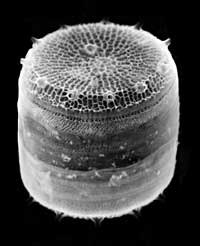WALNUT CREEK, CA–The first genetic instruction manual of a diatom, from a family of microscopic ocean algae that are among the Earth’s most prolific carbon dioxide assimilators, has yielded important insights on how the creature uses nitrogen, fats, and silica to thrive.

Thalassiosira pseudonana, like other diatoms, builds an exquisite species-specific frustule,or cell wall. Photo by Nils Kröger, Universität Regensburg.
The diatom DNA sequencing project, funded by the U.S. Department of Energy (DOE) and conducted at the DOE Joint Genome Institute, provides insight into how the diatom species Thalassiosira pseudonana prospers in the marine environment while it contributes to absorbing the major greenhouse gas CO2, in amounts comparable to all the world’s tropical rain forests combined.
“This critical information enables us to better understand the vital role that diatoms and other phytoplankton play in mediating global warming,” says Dan Rokhsar, who heads computational genomics at the JGI and is one of the co-authors of a research article in the Oct. 1 issue of Science. “Now that we have a glimpse at the inner workings of diatoms, we’re better positioned to understand how changes in their population numbers will translate into environmental changes and the global carbon management picture.”
“These organisms are incredibly important in the global carbon cycle,” says Virginia Armbrust, a University of Washington associate professor of oceanography and lead author of the Science paper. Together, the single-celled organisms generate as much as 40 percent of the 50 billion to 55 billion tons of organic carbon produced each year in the sea and in the process use carbon dioxide and produce oxygen. And they are an important food source for many other marine organisms.
Scientists would like to better understand how these organisms react to changes in sea temperatures, the amount of light penetrating the oceans, and nutrients.
“Oceanographers thought we understood how diatoms use nitrogen, but we discovered they have a urea cycle, something no one ever suspected,” Armbrust says. A urea cycle is a nitrogen waste pathway found in animals and has never before been seen in a photosynthetic eukaryote like a diatom, she says. Nitrogen is crucial for diatom growth and is often in short supply in seawater, depending on ocean conditions. The genome work revealed that the diatom Thalassiosira pseudonana has the genes to produce urea-cycle enzymes that may help to reduce its dependence on nitrogen from the surrounding waters.
The genome work also shed additional light on how this diatom species uses fats, or lipids, which it is known to store in huge amounts.
“Learning the actual pathways they use to metabolize their fats helps explain the ability of diatoms to withstand long periods with little sunlight–even to overwinter–and then start growing really rapidly once they return to sunlight,” she says.
Three or four microns in width–as many as 70 could fit in the width of a human hair–Thalassiosira pseudonana is among the smallest diatoms. Like its brethren, it is encased by a frustule, a rigid cell wall delicately marked with pores in patterns distinctive enough for scientists to tell the species apart. Another new finding reported in Science concerns the unusual way the diatom metabolizes silicon to form its characteristically ornate silica frustule.
“Diatoms can manipulate silica in ways that nanotechnologists can only dream about. If we understood how they can design and build their patterned frustule as part of their biology, perhaps this could be adapted by humans,” Rokhsar says.
Scientists on the project, which includes 46 researchers from 26 institutions, also considered the evolutionary implications revealed by the genomic work. The research provided direct genetic confirmation of a hypothesis that diatoms evolved when a heterotroph, a single-cell microbe, engulfed what scientists say was likely a kind of red alga. The two became one organism, an arrangement called endosymbiosis, and swapped some genetic material to create a new hybrid genome.
“This project helps illustrate the amazing diversity of life on our planet,” Armbrust says. “Diatoms display features traditionally thought to be restricted to animals and other features thought to be restricted to plants. Diatoms, with complete disregard for these presumed boundaries, have mixed and matched different attributes to create an incredibly successful microorganism. It’s exciting to imagine the novelty in the oceans that still awaits our discovery.”
Other JGI co-authors were Diego Martinez, Nicholas Putnam, J. Chris Detter, Tijana Glavina, David Goodstein, Uffe Hellsten, Susan Lucas, Mónica Medina, and Paul Richardson.
The U.S. Department of Energy Joint Genome Institute was established in 1997 as part of the Human Genome Project by combining the DNA sequencing resources from the three DOE national laboratories managed by the University of California: Lawrence Berkeley and Lawrence Livermore national laboratories in California, and Los Alamos National Laboratory in New Mexico. JGI has since extended the scope of its sequencing to whole-genome projects devoted to microbes and microbial communities, model system vertebrates, aquatic organisms, and plants. Funding for the JGI is predominantly from the Office of Biological and Environmental Research in the DOE Office of Science.